Is Your Skin Looking Dull, Rough, and Uneven?
Have you ever noticed certain areas of your skin looking dark, patchy, and flaky—especially around the elbows, knees, ankles, or face? You exfoliate and moisturize, but the spots remain stubborn, rough, and uneven. It’s frustrating, especially when you’re doing everything “right.”
Dark, flaky skin is more than just a cosmetic issue. It can signal chronic dryness, inflammation, hyperpigmentation, or an impaired skin barrier—and can worsen without the right care.
Why You’ll Love This Guide:
- Clinically backed remedies for hydration + brightening
- Natural solutions to even tone and reduce flakiness
- Long-term prevention tips for smoother, glowing skin
- Answers to your most common skincare concerns
Let’s explore what causes this condition—and more importantly, how to heal and prevent it the right way.
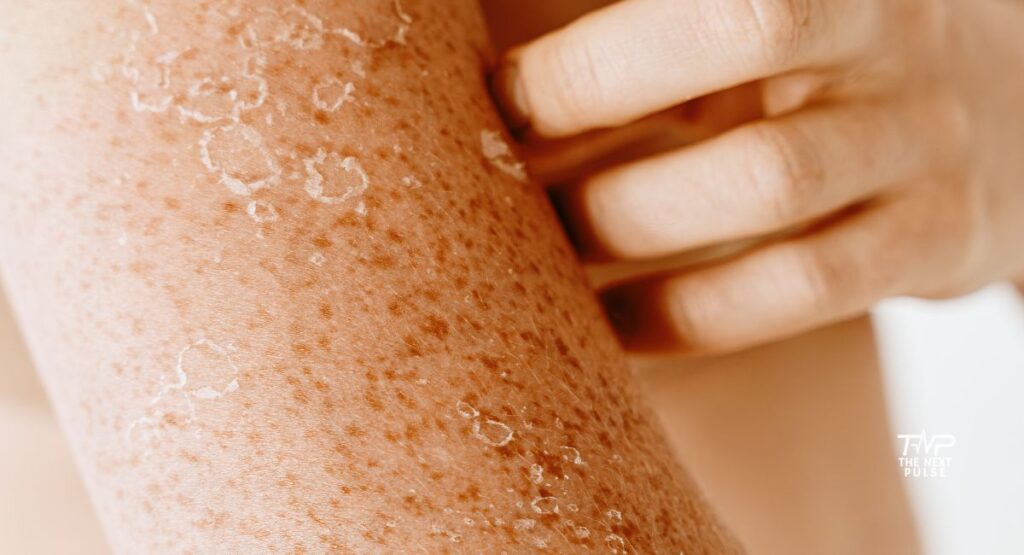
Problem Breakdown: What Is Dark, Flaky Skin?
Dark, flaky skin refers to skin that has both hyperpigmentation (dark patches) and visible dryness or peeling. This combination typically results from chronic irritation, inflammation, or damage to the skin barrier.
Appearance:
- Dry, rough, scaly patches that may peel
- Areas appear darker than surrounding skin (brown, grayish, or ashy tone)
- Common on knees, elbows, shins, knuckles, underarms, and sometimes cheeks
- May be itchy, tight, or sensitive to touch
Common Triggers:
Environmental & Lifestyle:
- Cold, dry weather or frequent sun exposure
- Hot showers and over-cleansing
- Friction (from shaving, tight clothing, or excessive rubbing)
- Use of harsh soaps, scrubs, or alcohol-based products
Internal/Medical Causes:
- Post-inflammatory hyperpigmentation (PIH) due to eczema, psoriasis, or acne
- Keratosis pilaris or ichthyosis vulgaris (genetic dry skin conditions)
- Acanthosis nigricans (often related to insulin resistance)
- Vitamin deficiencies (A, E, D, or essential fatty acids)
The overlap of dryness and pigmentation requires a dual-action approach: moisturize and brighten while reducing inflammation.
Medical Solutions: Dermatologist-Recommended Treatments
If home remedies aren’t cutting it, here are evidence-based treatments a dermatologist may recommend.
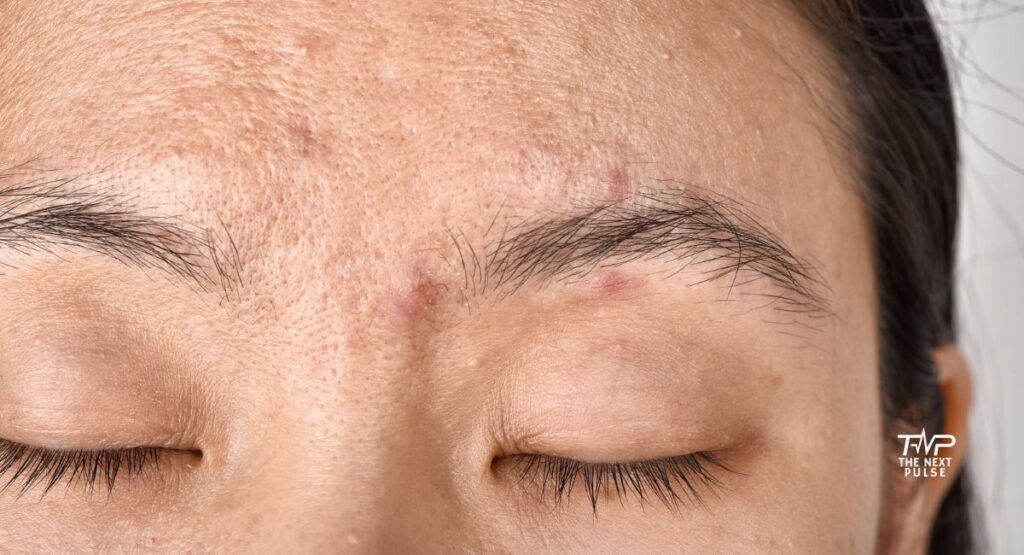
1. Hydroquinone or Azelaic Acid Creams
- Use: Lighten hyperpigmented areas
- Duration: 4–8 weeks for visible results
- Note: Hydroquinone should be used under medical supervision to avoid overuse or ochronosis.
2. Retinoids (Tretinoin or Adapalene)
- Benefit: Promotes cell turnover, evens tone, reduces scaling
- Precaution: May cause initial dryness—start slowly and moisturize well
3. Urea or Lactic Acid Lotions (10–20%)
- Use: Break down rough, thickened skin and hydrate
- Ideal For: Knees, heels, elbows, or anywhere with thickened flakes
4. Chemical Peels (AHA or BHA-based)
- Performed By: Dermatologist or medical aesthetician
- Benefits: Exfoliates dead skin, reduces pigmentation, smooths texture
5. Laser Treatments
- Type: Fractional laser or Q-switched laser
- Best for: Deep or stubborn pigmentation from past trauma or eczema
- Sessions Needed: 3–6 sessions, spaced 4–6 weeks apart
Home Remedies: Gentle, Science-Backed Solutions
Natural doesn’t have to mean ineffective. These home treatments can hydrate, lighten, and soothe flaky, darkened skin when used consistently.
1. Aloe Vera + Turmeric Paste
- How to Use: Mix 1 tbsp aloe vera gel with a pinch of turmeric. Apply to dark, dry patches for 15 minutes before rinsing.
- Benefits: Anti-inflammatory, brightens pigmentation, soothes dry skin
- Visible Improvement: 2–3 weeks
2. Oatmeal + Yogurt Exfoliating Mask
- How to Use: Combine ground oats and plain yogurt. Gently scrub in circular motions once weekly.
- Benefits: Natural lactic acid exfoliation + moisturization
- Best For: Flaky areas on the face, arms, or chest
3. Raw Honey + Lemon Juice (Patch Test First!)
- How to Use: Mix 1 tsp each and apply only on body (not face). Leave on for 10 minutes.
- Caution: Lemon can be irritating; always patch test and avoid sun exposure immediately after
- Use: 1–2x/week
4. Coconut Oil + Vitamin E
- How to Use: Mix a few drops of vitamin E oil into warm coconut oil and massage into dry, dark patches nightly
- Ideal For: Knees, elbows, knuckles
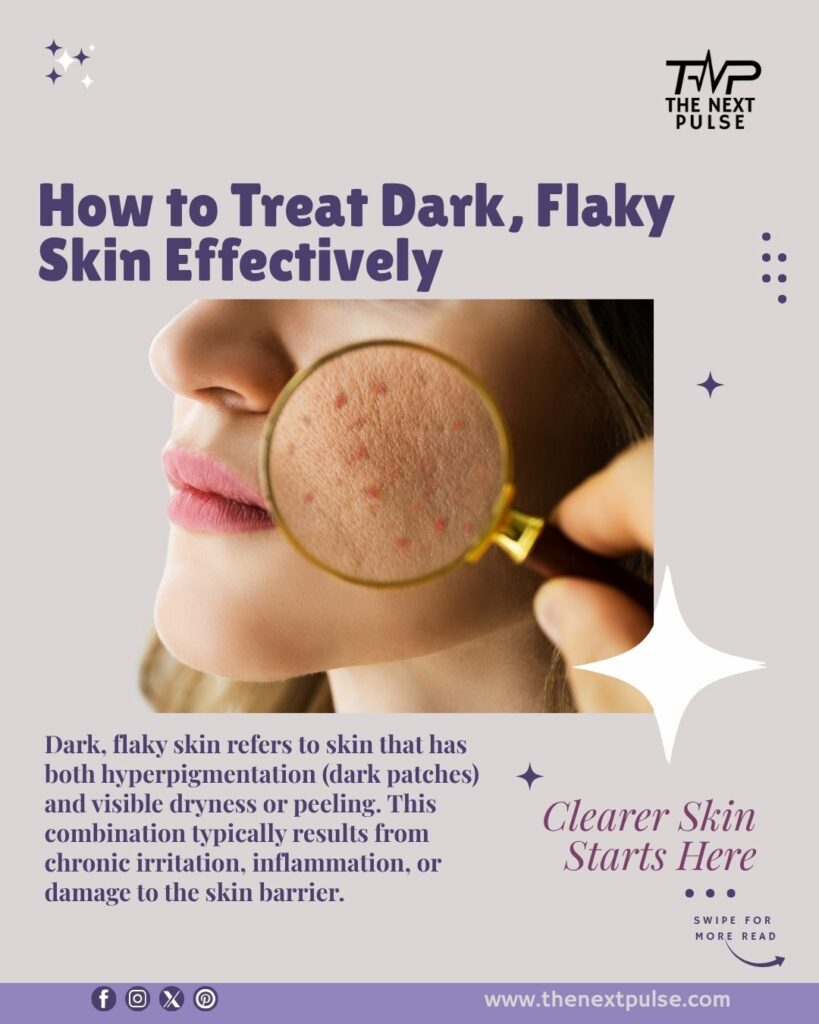
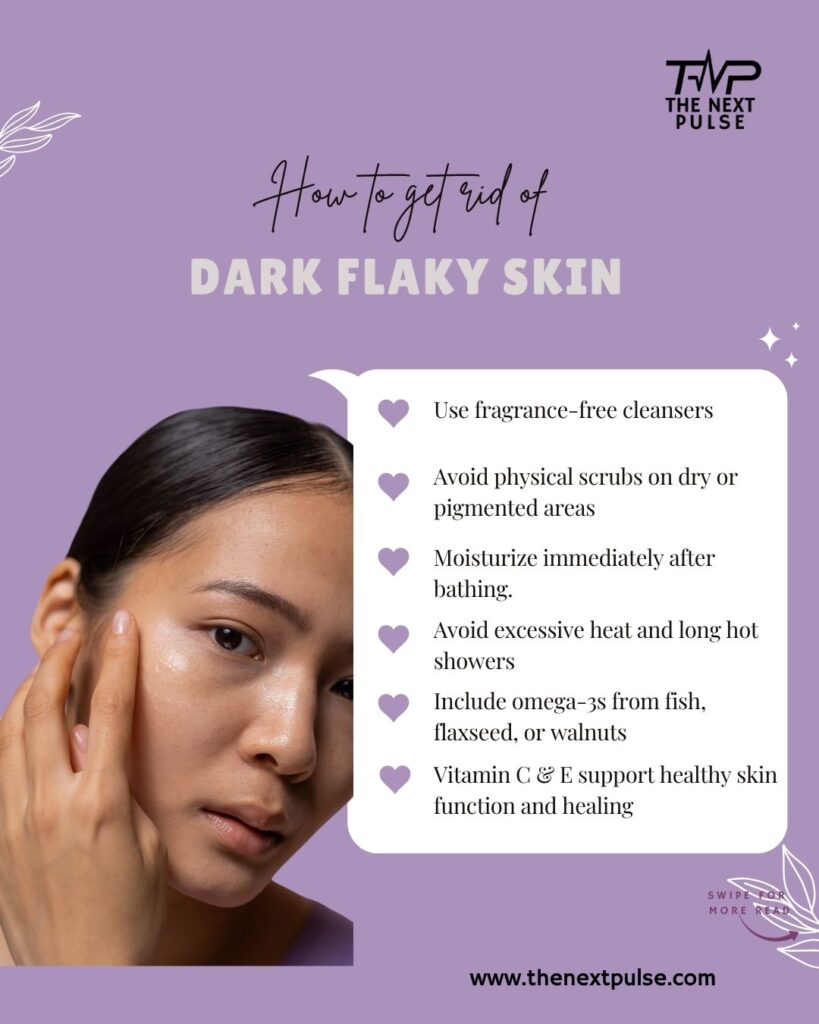
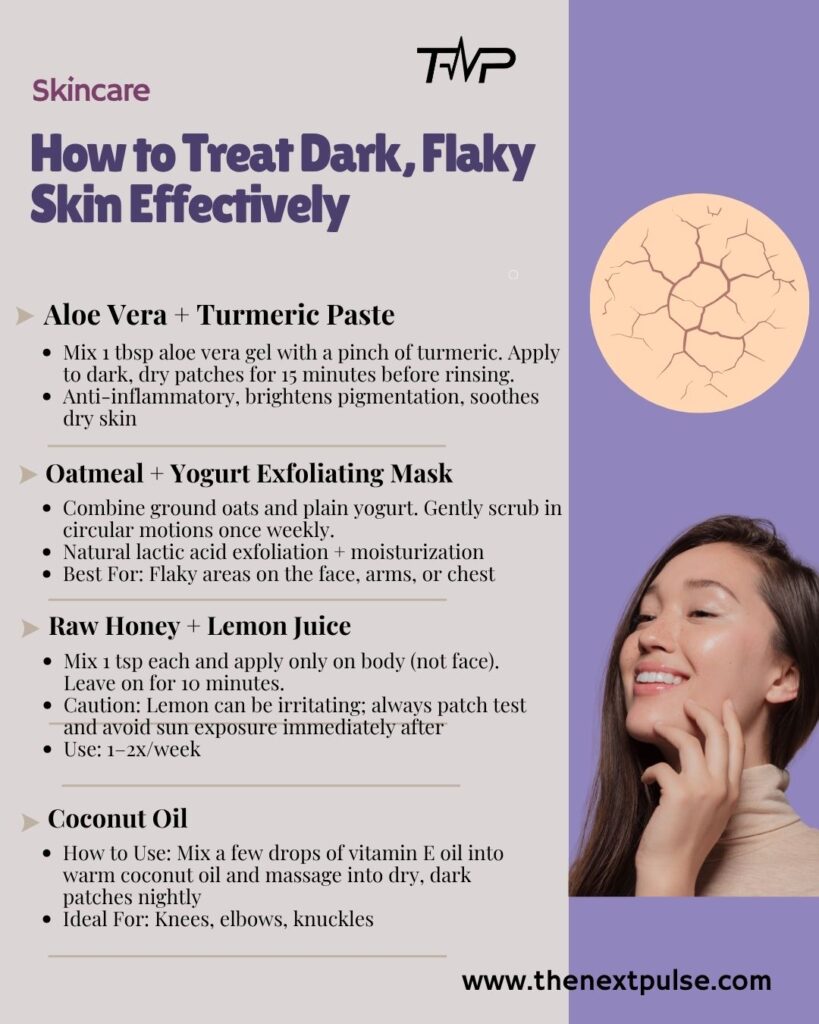
Additional Tips for Prevention & Maintenance
Smart Skincare Habits:
- Use fragrance-free cleansers
- Avoid physical scrubs on dry or pigmented areas
- Moisturize immediately after bathing (use occlusives like petrolatum or ceramides)
Gentle Lifestyle Changes:
- Wear loose, cotton clothing to reduce friction
- Avoid excessive heat and long hot showers
- Apply SPF daily, even on cloudy days, to prevent further pigmentation
Skin-Nourishing Diet:
- Eat foods rich in vitamins A, C, D, and E
- Include omega-3s from fish, flaxseed, or walnuts
- Stay well-hydrated throughout the day
👨⚕️ Pro Tip: “The best way to treat dark, flaky skin is to focus on barrier repair first, then treat pigmentation. Trying to fade dark spots without healing dryness can make things worse.”
— Dr. Sara Khan, Board-Certified Dermatologist
FAQs
1. Can stress worsen dark, flaky skin?
Yes. Stress can impair skin barrier repair and trigger inflammatory conditions like eczema or psoriasis, which worsen discoloration and flaking.
2. Is it okay to exfoliate flaky skin daily?
No. Over-exfoliating can worsen dryness and pigmentation. Limit exfoliation to once or twice per week, and always follow with a rich moisturizer.
3. Can I use vitamin C on dark, flaky skin?
Yes—but only after your skin is well-moisturized and barrier-friendly. Use a gentle vitamin C serum with added hydrators.
4. Is dark, flaky skin permanent?
Not always. With consistent care, lifestyle changes, and sometimes medical treatment, most cases significantly improve or fully resolve.
5. When should I see a dermatologist?
If dark, scaly patches persist beyond 4 weeks or spread, consult a dermatologist. This could signal conditions like eczema, fungal infections, or acanthosis nigricans.
Final Thoughts
Dark, flaky skin can feel stubborn and unflattering—but with the right knowledge and care, you can restore smoothness and even tone. Addressing both hydration and pigmentation is key. Start with gentle care, and don’t hesitate to get professional help if needed.
Your skin deserves consistency, compassion, and expert-backed care.
{ “@context”: “https://schema.org”, “@type”: “Article”, “mainEntityOfPage”: { “@type”: “WebPage”, “@id”: “https://thenextpulse.com/how-to-treat-dark-flaky-skin-effectively/” }, “headline”: “How to Treat Dark, Flaky Skin Effectively: Dermatologist-Approved Remedies for Brighter, Smoother Skin”, “image”: [ “https://thenextpulse.com/wp-content/uploads/2025/10/dark-flaky-skin-11-1024×555.jpg” ], “datePublished”: “2025-10-05”, “author”: { “@type”: “Person”, “name”: “Javeria Khadim” }, “publisher”: { “@type”: “Organization”, “name”: “The Next Pulse”, “logo”: { “@type”: “ImageObject”, “url”: “https://thenextpulse.com/wp-content/uploads/2025/08/cropped-1-icon-1.png” } }, “description”: “A detailed guide on how to treat dark, flaky skin using dermatologist-recommended treatments, home remedies, and prevention tips.”, “articleSection”: “Skin Care”, “keywords”: “dark skin, flaky skin, hyperpigmentation, exfoliation, moisturizer, skin barrier repair” }